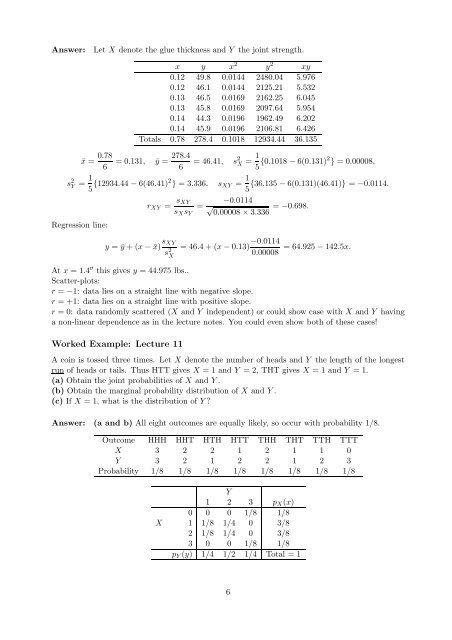MATH1725 Introduction to Statistics: Worked examples
MATH1725 Introduction to Statistics: Worked examples
MATH1725 Introduction to Statistics: Worked examples
You also want an ePaper? Increase the reach of your titles
YUMPU automatically turns print PDFs into web optimized ePapers that Google loves.
Answer: Let X denote the glue thickness and Y the joint strength.<br />
x y x 2 y 2 xy<br />
0.12 49.8 0.0144 2480.04 5.976<br />
0.12 46.1 0.0144 2125.21 5.532<br />
0.13 46.5 0.0169 2162.25 6.045<br />
0.13 45.8 0.0169 2097.64 5.954<br />
0.14 44.3 0.0196 1962.49 6.202<br />
0.14 45.9 0.0196 2106.81 6.426<br />
Totals 0.78 278.4 0.1018 12934.44 36.135<br />
¯x = 0.78<br />
6<br />
= 0.131, ȳ = 278.4<br />
6<br />
= 46.41, s 2 X = 1 5 {0.1018 − 6(0.131)2 } = 0.00008,<br />
s 2 Y = 1 5 {12934.44 − 6(46.41)2 } = 3.336,<br />
s XY = 1 {36.135 − 6(0.131)(46.41)} = −0.0114.<br />
5<br />
Regression line:<br />
r XY = s XY<br />
s X s Y<br />
=<br />
−0.0114<br />
√ 0.00008 × 3.336<br />
= −0.698.<br />
y = ȳ + (x − ¯x) s XY<br />
s 2 X<br />
= 46.4 + (x − 0.13) −0.0114<br />
0.00008<br />
= 64.925 − 142.5x.<br />
At x = 1.4 ′′ this gives y = 44.975 lbs..<br />
Scatter-plots:<br />
r = −1: data lies on a straight line with negative slope.<br />
r = +1: data lies on a straight line with positive slope.<br />
r = 0: data randomly scattered (X and Y independent) or could show case with X and Y having<br />
a non-linear dependence as in the lecture notes. You could even show both of these cases!<br />
<strong>Worked</strong> Example: Lecture 11<br />
A coin is <strong>to</strong>ssed three times. Let X denote the number of heads and Y the length of the longest<br />
run of heads or tails. Thus HTT gives X = 1 and Y = 2, THT gives X = 1 and Y = 1.<br />
(a) Obtain the joint probabilities of X and Y .<br />
(b) Obtain the marginal probability distribution of X and Y .<br />
(c) If X = 1, what is the distribution of Y <br />
Answer: (a and b) All eight outcomes are equally likely, so occur with probability 1/8.<br />
Outcome HHH HHT HTH HTT THH THT TTH TTT<br />
X 3 2 2 1 2 1 1 0<br />
Y 3 2 1 2 2 1 2 3<br />
Probability 1/8 1/8 1/8 1/8 1/8 1/8 1/8 1/8<br />
Y<br />
1 2 3 p X (x)<br />
0 0 0 1/8 1/8<br />
X 1 1/8 1/4 0 3/8<br />
2 1/8 1/4 0 3/8<br />
3 0 0 1/8 1/8<br />
p Y (y) 1/4 1/2 1/4 Total = 1<br />
6

















